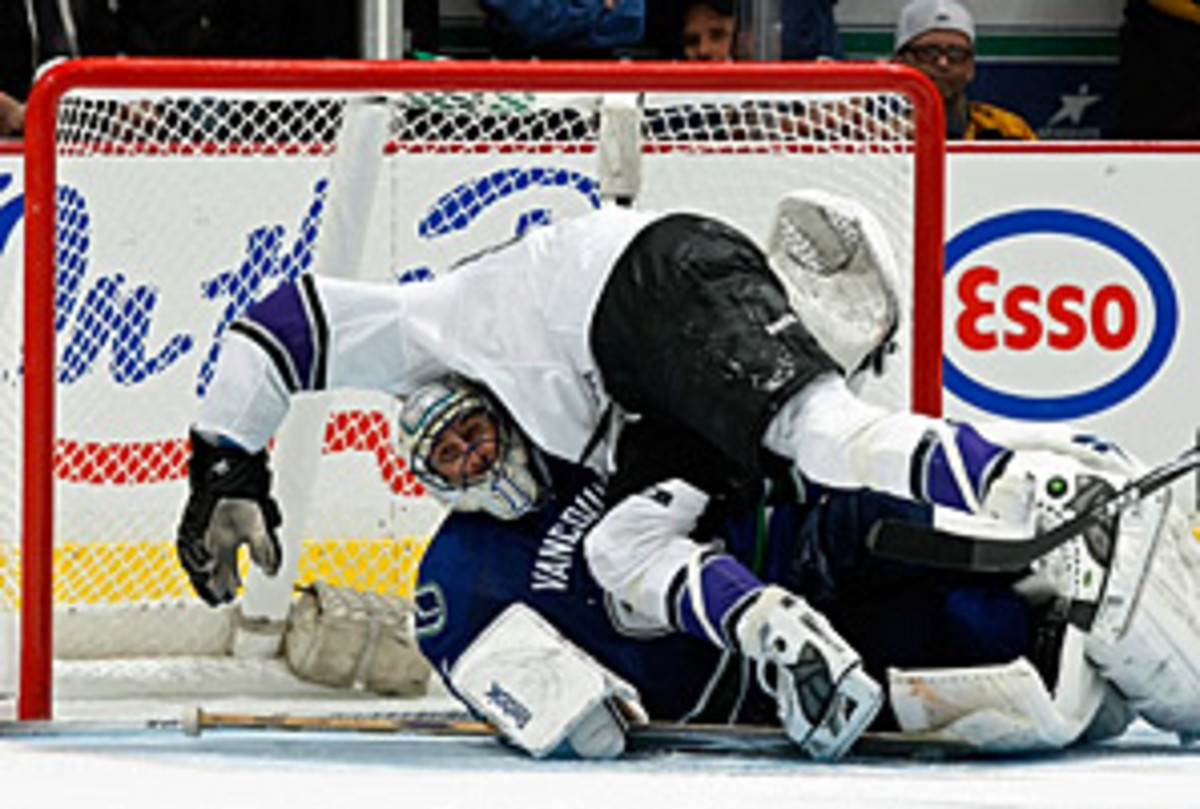Goalies no longer worth big risk
A lot has happened around the NHL this summer and it's interesting to look at how certain things have changed. In particular, I've been intrigued by what has gone on with goaltenders. It certainly appears as if we are entering a new phase in how teams view the position from the perspective of slotting goalie salaries in the cap era.
The NHL's hard salary cap is the obvious first dynamic at work here. How much money can a team afford to sink into one position? The Montreal Canadiens opted to trade playoff hero Jaroslav Halak instead of finding a way to sign him and Carey Price. Longtime San Jose Shark Evgeni Nabokov bolted for the KHL when it became evident that no NHL team was going to continue to pay him $6 million-plus a season. And the Stanley Cup champion Chicago Blackhawks walked away from an arbitration award that tripled Antti Niemi's salary to $2.75 million -- this after he backstopped them to their first Stanley Cup since 1961. Talk about unceremonious.
Yet, those are the realities of the marketplace for puck-stoppers. In an uncapped world, maybe the Habs hold onto Halak and Price, or at least have more leverage for a trade because there wouldn't be the sense that they had to move one or the other. In Niemi's case, he is just one of several cap-casualties in Chicago -- a summer that GM Stan Bowman knew was coming, Cup or no Cup, but anticipation is one thing. Seeing the champs cut to the core so soon after their triumph reverberates even in August. And with Niemi cut loose, enter veteran free agent Marty Turco for less than $1.5 million a season -- a $4 million pay cut of the kind that sent a guy like Nabokov overseas.
Mind you, there are still big goalie contracts on the books, led by Roberto Luongo's $10 million salary this coming season. According to NHLPA.com, Luongo, Tomas Vokoun, Nik Backstrom, Miikka Kiprusoff and J-S Giguere are the highest-paid players on their respective teams. HenrikLundqvist will pull in $7 million and Tim Thomas will gross $6 million while Marty Brodeur, Marc-Andre Fleury and Cam Ward round out the list of goalies who will make at least $5 million. Of these heavy hitters you have some who are collecting for previous services rendered on contracts that no longer make sense for the economic climate (Kiprusoff, Giguere and Thomas particularly). It is also noteworthy that five of the 10 listed didn't even make the playoffs last season and Thomas lost his number one status with Boston to Tuukka Rask long before the Bruins went to the Eastern Conference semi-finals.
When Brodeur and the Devils lose in the first round of the playoffs for the third successive season and the Blackhawks prevail with a rookie like Niemi, the guys holding the purse strings are going to reevaluate their cash position in the crease. Since the lockout, the championship goaltenders have been Ward and Niemi as rookies, veteran Chris Osgood on a bounce-back contract similar to Turco's, and Fleury. As first round picks and with Stanley Cups on their resumes, Fleury and Ward figured to be part of their teams' core group, thus their current level of compensation. But the tale of the big-ticket netminder is more cautionary these days for more than just economic concerns.
The last five years have seen the game ramp up speed on attack, with more movement away from the puck as it nears the crease. Goaltenders have to contend with more quality chances than they did during the "dead puck" era (pre-2005). Remember the days of zero tolerance for crease violations when the league seemed to spend more time reviewing plays that led to goals being removed from the scoreboard? Those days are gone, thankfully. So, too, are the smiles from the goalies' faces because lateral attack strategies are back in the game. Moving side-to-side to make a save is tougher than handling everything straight on and it leaves a goalie more exposed and prone as he slides in butterfly to make a save.
Locking so much money into one player -- who is at a higher risk of injury than at any time over the past 15 years -- requires extra thought. And I'm not talking about injury due to contact. More the back, hip, knee and ankle ailments that seem chronic when you combine today's butterfly style of play with the mode of offense emerging these days. Luongo, Ward, Fleury and Backstrom all missed time due to injury this past season. No one, though, symbolizes the economic risk of salary loading in goal than Rick DiPietro. He has appeared in only 13 games over the past two seasons after injuring himself at the 2008 All-Star Game -- this after signing an absurd-at-the-time 15-year deal.
Since then, long-tern deals have become all the rage as a means of manipulating the salary cap. But peril remains in investing so much in one player at one position where recent history seems to show that building a robust team with a mobile blueline is the best way to go. It need only be backed by solid rather than star-studded goaltending. And make no mistake: DiPietro was a star. Now he remains a question mark despite the guarantees of term and his $4.5 million salary this season. He is working on his leg strength conditioning as he prepares for camp. He says he is ready to go, but truly no one knows. The Islanders will wait and see and can only take DiPietro's say-so as to how he feels.
It's too bad for DiPietro, and the Islanders because they are a young team on the rise. He was supposed to be at the center of it. He still might be. But maybe not. And that's why the emphasis on the man in the crease is shifting.






